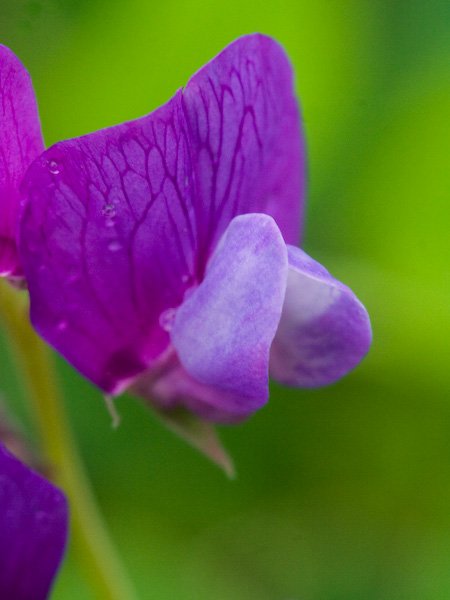A couple of weeks ago, I went along on a trip to Kruzof Island to hike Mt. Edgecumbe. I had previously noted Apargidium (Microseris borealis) and Beach Pea (Lathyrus japonicus) growing on Kruzof, two plants I have never noticed along the Sitka road system. It is easy enough to explain Beach Pea, as it seems to like sandy beaches, common on Kruzof, but largly absent on the road system.
 Apargidium is another matter. It is common in the Kruzof Island muskegs I have visited, both close to sea level, and well up on the slopes of Mt. Edgecumbe, however I have never seen it in a muskeg on Baranof Island.
Apargidium is another matter. It is common in the Kruzof Island muskegs I have visited, both close to sea level, and well up on the slopes of Mt. Edgecumbe, however I have never seen it in a muskeg on Baranof Island.
This trip I noticed three additional plants that were fairly common in muskegs along at least part of the trail that I have never observed in muskegs close to town.
 The first plant I noticed was Sweet Gale (Myrica gale). It was common in the muskeg just inside the beach forest. Despite its abundance in the first of the muskegs, it disappeared quickly as the trail moved inland.
The first plant I noticed was Sweet Gale (Myrica gale). It was common in the muskeg just inside the beach forest. Despite its abundance in the first of the muskegs, it disappeared quickly as the trail moved inland.
 Hooded Lady’s Tresses (Spiranthes romanzoffiana) was quite common along the middle portion of the trail. As the trail went up after the shelter, it seemed less abundant, and I do not remember noticing it much (or perhaps not at all) along the lower sections. Apparently a fairly late bloomer, as it seemed to be in peak bloom on this mid-August hike.
Hooded Lady’s Tresses (Spiranthes romanzoffiana) was quite common along the middle portion of the trail. As the trail went up after the shelter, it seemed less abundant, and I do not remember noticing it much (or perhaps not at all) along the lower sections. Apparently a fairly late bloomer, as it seemed to be in peak bloom on this mid-August hike.
 I also noticed what I presume to be Small-flowered Lousewort (Pedicularis parviflora). It seemed less common (or at least not as showy, and so less noticed) than the other plants, but my recollection is it was not too hard to find beside the trail along the middle section.
I also noticed what I presume to be Small-flowered Lousewort (Pedicularis parviflora). It seemed less common (or at least not as showy, and so less noticed) than the other plants, but my recollection is it was not too hard to find beside the trail along the middle section.
A final plant that I did not see, but heard were fairly common (and blooming) earlier in the summer in the beach forest near Fred’s Creek is the Calypso Orchid (Calypso bulbosa). I have seen these in Washington and Idaho, and knew they grow in Southeast, though I have not yet had the opportunity to see them blooming here. They seem to be absent along the road system.
Unfortunately, I did not pay enough attention to what plants were missing that I typically find in muskegs along the road system. I do remember that False-asphodel (Triantha spp.) did not seem as abundant as I often see, though it was present. I guess on my next trip, I will try to do a better job of considering what plants I might expect to see, but don’t.
I wonder the reason for differences in flora, especially in the muskegs. The climate cannot be too different, though perhaps it has an effect. I would guess that temperatures tend to be slightly warmer and precipitation is likely different, though I do not know in which direction. My initial guess would be that it is drier on Kruzof (due to the effect of the mountains on Baranof causing the air to lift, cool, and precipitate). It seems more likely to me that it’s an edaphic reason (I just recently learned the word ‘edaphic’; it means having to do with soils). Dispersal could play a role, though given the relatively short distances, it seems unlikely that something could disperse to Kruzof enough to get established and not make it to Baranof, if conditions were hospitable.

1 thought on “Comments and Questions about Kruzof Island Plants”